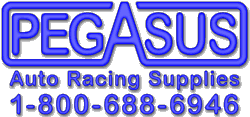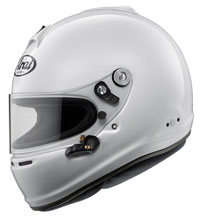How should a helmet fit?
A helmet should be tight but not so tight as to be uncomfortable. You should feel firm contact all the way around your head, and the pressure should be evenly distributed. Keep in mind the padding will compress a little as you wear the helmet, so a new helmet should feel tighter than your old helmet.
How do I measure my head?
Use a flexible tape measure (not your metal shop tape measure) approximately one inch above the eyebrows in front and at a point in the back of the head that results in the largest possible measurement.
What do the different helmet ratings mean?
The two main helmet rating organizations in the USA are the Snell Memorial Foundation and the SFI Foundation. Snell rates auto racing helmets under M, SA, or K standards.
M stands for Motorcycle (or Motorized vehicles). M rated helmets are used for motorized highway vehicles and for racing that does not require a fire-retardant lining. The M rating also requires a larger eyeport for a wider range of vision. The M rating is typically updated every 5 years.
SA stands for Special Application. SA rated helmets are used in competitive automobile racing and require a fire-retardant lining. SA helmets are also subjected to additional testing including a test that simulates a roll bar impact. The SA rating is currently revised every 5 years.
K stands for Karting. K rated helmets are subjected to the same tests as SA helmets except they do not require a fire-retardant lining.
Please consult your sanctioning body for specific helmet requirements.
What is new for the Snell SA2020 standard?
The differences between the SA2015 and SA2020 standards are minor. The new SA2020 impact tests are more demanding, bringing them more in alignment with the FIA 8860 tests. As with the Snell SA2015 standard, all helmets are required to have M6 female threaded inserts installed in the shell to accept head and neck restraint anchors. Low-velocity impact tests simulate minor bumps against a rollcage, and "low-lateral" tests simulate striking a side window frame. The specific testing procedures are gradually becoming more in-line with FIA standard 8859-2015, but Snell SA2020 certification does not automatically grant FIA certification.
How long will an SA2015 helmet be good for?
Unfortunately, most racing organizations have not announced their changeover plans yet, so it is impossible to give a solid answer. In previous years, SCCA has allowed the current SA standard plus the previous standard (for 2019, that meant SA15 and SA10). In the past, the rule has usually been updated to take effect after helmets the newest standard have been available for one full year.
For example, SA05 helmets were accepted through 2016 (SA15 helmets went on sale in October 2015); SA10 helmets were accepted through 2021 (SA20 helmets went on sale in October 2020). If the SA25 and SA30 changeovers follow the same schedule, SA15 helmets will be accepted through 2026 and SA20 helmets would be accepted until the end of 2031. Note that every racing organization is different. Please check your rulebook.
What is the difference between the Snell SA and SFI 31.1 helmet standards?
Both standards are similar, but they vary in the specifics of their tests. The impact tests for both standards require weighted drops at high, medium, and low speeds onto flat, hemispherical, edge, and roll bar anvils that simulate real world impacts. Both standards require testing in cold, ambient, hot, and wet conditions to simulate a variety of racing environments. Both standards require fire retardance testing, shell penetration testing, retention system testing, and shield testing.
Note that unlike Snell, SFI does not perform any helmet testing. Snell performs the testing and randomly re-tests helmets purchased through retail outlets. SFI allows manufacturers to use the SFI label based on test results provided by the manufacturers.
Many sanctioning bodies now recognize both SFI and Snell helmet standards. Please check your rulebook to be sure.
What is the difference between the various SFI helmet standards?
The first SFI helmet standards were SFI 31.1A (open face auto racing), SFI 31.2A (full-face auto racing), SFI 41.1A (open-face motorcycle), and SFI 41.2A (full-face motorcycle). The "A" was later replaced by the year of the standard (e.g., SFI 31.1/2005, which coincided with Snell SA2005), and the distinction between open-face and full-face helmets was dropped. In 2013, the date was also dropped. The current standards are SFI 24.1 (youth helmets only), SFI 31.1 (auto racing, similar to Snell SA) and SFI 41.1 (motorcycle, similar to Snell M).
Who accepts the SFI helmet standard?
SCCA, NHRA, NASCAR, and many other USA-based series across most forms of motorsports. Please check your rulebook.
How do I care for my helmet?
Helmets should be stored clean and dry, away from extreme heat or extreme cold. Keep your helmet away from petroleum products or other corrosives as these can have unexpected results on even the strongest composite materials and resins. Helmets should be stored out of direct sunlight, preferably in a padded bag. Dropping the helmet, even from just a few feet off the ground, can damage the shell. The shell and the inner liner may be cleaned with warm soapy water.
What is the proper way to clean a face shield?
Avoid using paper towels, as these can scratch the shield. Thinners, solvents, plastic polishes, and other harsh chemicals can destroy the shield material. Chrome, iridium, "Blue Blocker", and other reflective coatings can also be damaged by ordinary household window cleaner. On most shields, a mild soapy solution (preferably sprayed on) and a clean, soft rag will do the job.
We recommend lens cleaner and cleaning cloths formulated for coated lenses. These are available at most drugstores, camera shops, or optometrists. Use a liberal amount of lens cleaner and do not scrub the shield. Gently wipe away the dirt and pat the shield dry.
The inside of Bell Fog Free shields and inserts should be cleaned by rinsing with warm water only. Automotive wax (not "cleaner wax", which has abrasives) can be used to protect the fog free coating.
Is it OK to paint my helmet?
Helmet manufacturers recommend leaving the job to a trained helmet painter who specializes in auto racing helmets. These professionals know to use acrylic enamels (never lacquer), and they know how to protect the inner liner from the solvents which can cause serious damage.
We also strongly recommend trying your helmet on before painting. Once a helmet is painted, it's yours to keep.
When should I replace my helmet?
Even the best materials degrade over time, and the high-performance, lightweight materials currently in use are no exception. Sunlight, ozone, perspiration, and even everyday bumps and knocks all take their toll on the shell and the inner liner. Snell recommends helmet replacement after 5 years of use, or immediately after any incident. Remember, the consequences of auto racing incidents can be violent and permanent. Only use safety equipment that is in top condition. When in doubt, replace it.
What should I do if my helmet is in an impact?
Helmets should always be inspected after an incident. Outside of the helmet look for delamination (separation of the shell layers), surface cracking, and exposed fiberglass or composite material under the paint finish. Inside the helmet look under the soft foam padding for signs that the inner liner has been compressed. Bear in mind that even the most thorough visual inspection can fail to detect signs of damage. If you have any doubts, send the helmet back to the manufacturer for inspection. Most helmet manufacturers will provide this inspection free of charge.
More Technical Documents About Safety Equipment
Auto Racing Helmets
Helmet Face Shields
Helmet Bags
This article was first published on 5/31/2010.
It was most recently modified on 4/4/2022.


